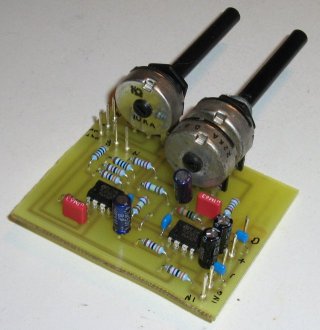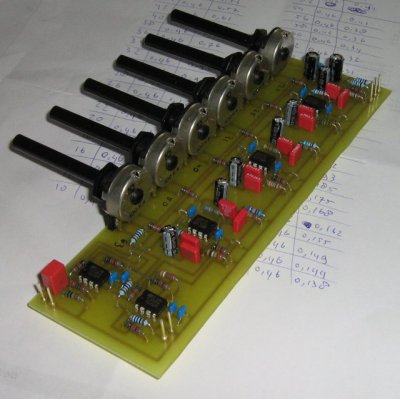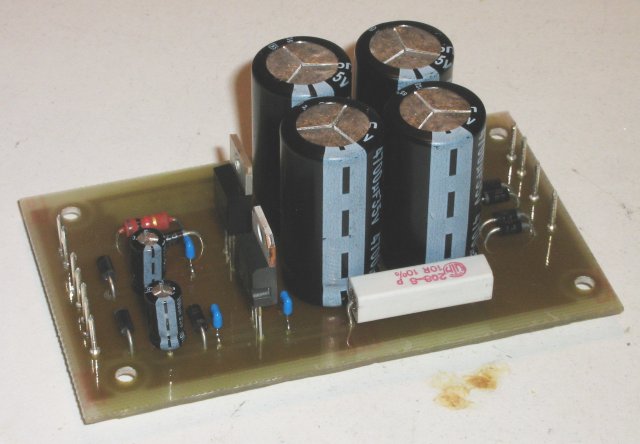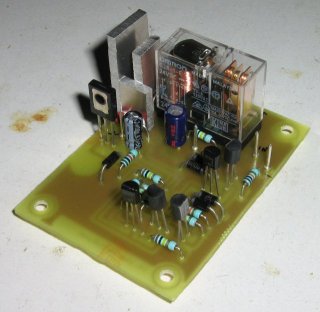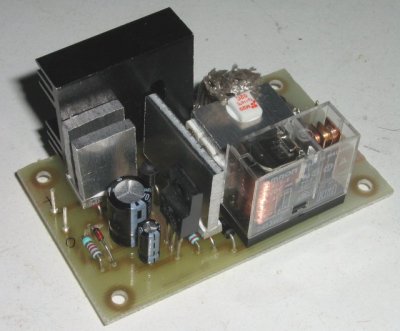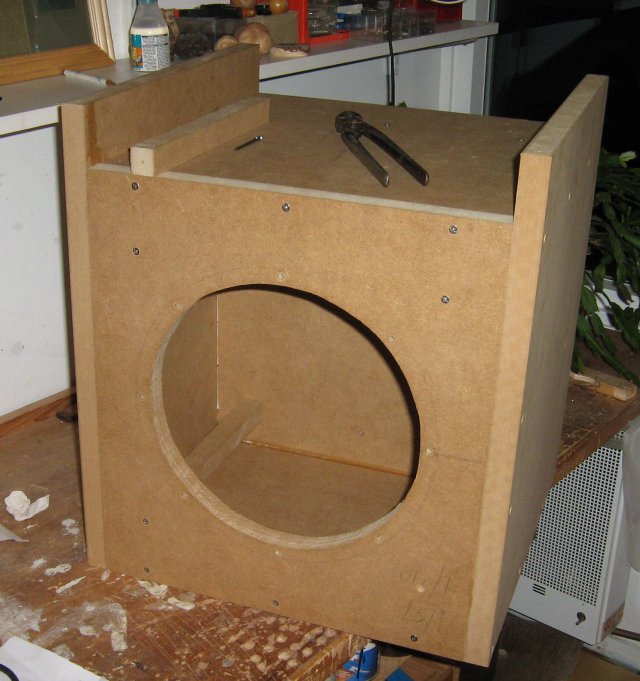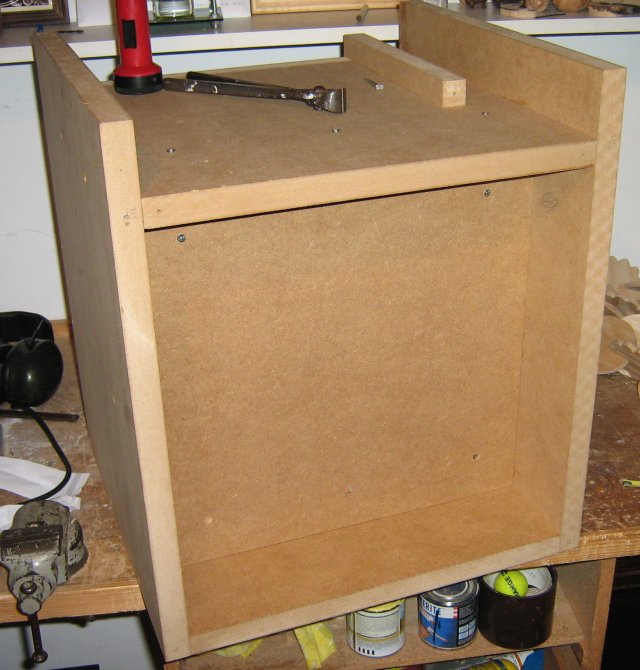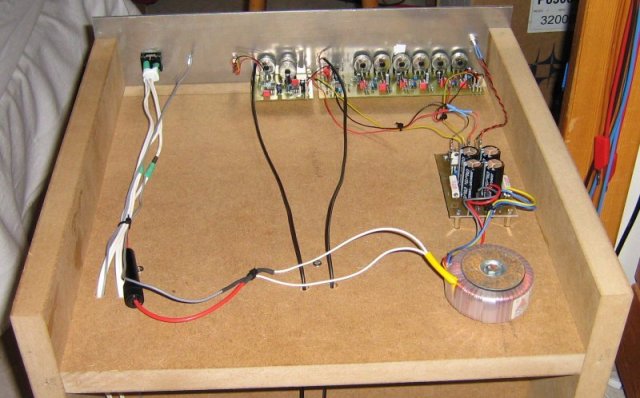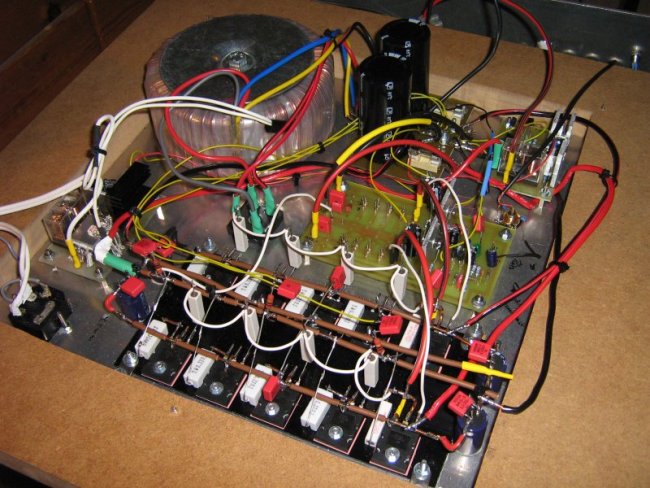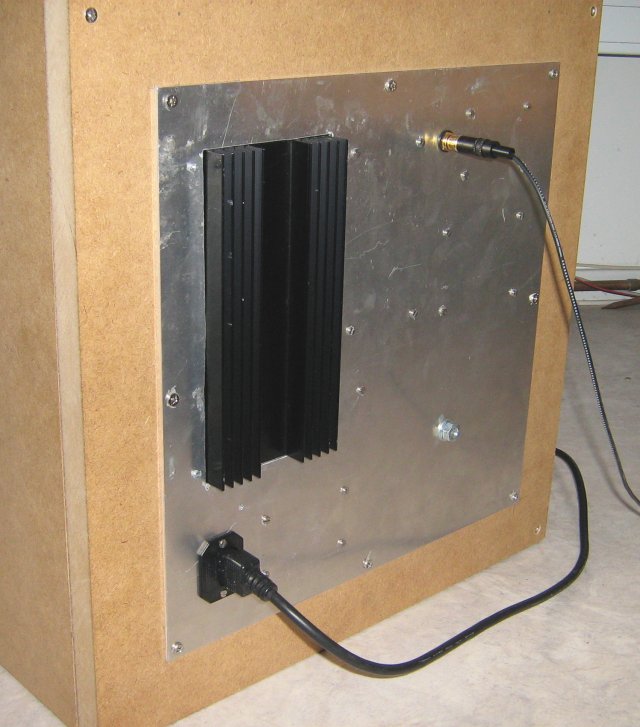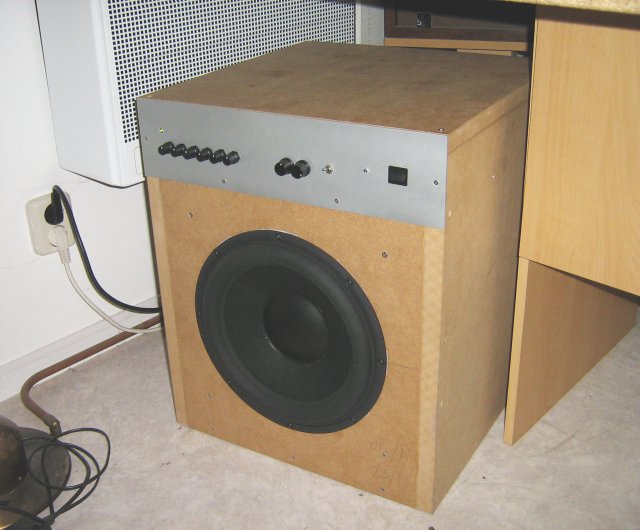Extended low frequency subwoofer
1. Introduction
The low frequency foundation of sound is a very important aspect to the experience, be it in music or in movies (and not just action movies). Reproducing it can be quite a challenge. As I sometimes do, I was browsing Rod Elliott's Audio Pages and I found the ELF subwoofer processor. The concept was very appealing to me, so I decided to build it.
The details are explained in Rod Elliott's article, but I'll explain the basic theory briefly. Normal speakers use their cabinets as resonant chambers to amplify the sound produced by the driver. This poses some problems, like unpredictable response, impedance peaks and the requirement of a very large box for deep bass. Designing a speaker like this is also quite difficult, because a lot can go wrong. With ELF, you drive the system below its resonance frequency only. Normally, this means a drop in SPL of 12 dB per octave you go down. This drop is then undone by amplifying the signal by 12 dB per octave down. The result is having a system with predictable response, which can go down to well below the minimum frequency humans can hear (but you don't want that, because it would take too much power). Because of this amplification, you need a high power driver with high Xmax and a high power amplifier which is going to drive it.
Later, I built a second version of this design, which you can find here.
2. Design choices
2.1. The driver and the box
First, I needed to know what kind of driver I was going to use. 15" Was recommended, which I initially intended to use, but 15" drivers are somewhat hard to come by, I discovered. So, I settled on 12". I narrowed the list down to several Peerless subwoofer drivers, of which I eventually chose the 830847. The reason for this decision was based on simulations done in WinISD Pro alpha, and because it had the ability to be wired as 4 Ohm, which prevented me from having to bridge two amplifiers.
Simulations showed that the 12" driver might actually be insufficient to get the performance I wanted, mostly in terms of Xmax. To keep the power demands in check, I decided to go for a maximum frequency of about 50 Hz (which required a box of 40 litres), which suited my main speakers quite nicely. WinISD Pro doesn't have a simple 12 dB per octave down filter correction, but because I'm only interested in below resonance, a Linkwitz Transform (which is similar to ELF, but more complicated) filter with F0=50 Hz will be close enough. I unfortunatly don't have an SPL meter, but I believe that Dolby specifies a reference SPL of 105 dB, which I wanted to be able to achieve. But even at 101 dB at 50 Hz (which required 20 watts), the Xmax of my driver was being exceeded for the lower end of the frequency range, as shown in the following graphs.
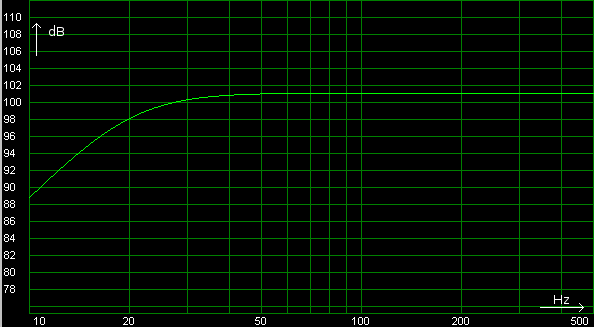
SPL at 20 watt input, 1 meter, with Linkwitz Transform correction
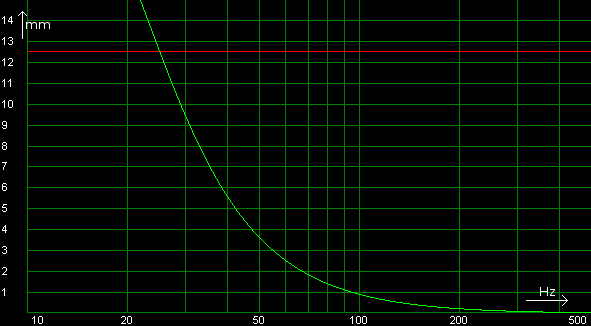
Cone excursion at 20 watt input, with Linkwitz Transform correction
I decided (and hoped) it wasn't going to pose much of a problem, because reality is very different from theory. First of all, 20-25 Hz sounds are not present that much, energy content of low frequencies is often much lower than the rest (although this is not really the case for movies). Additionally, the simulations didn't take room gain into account.
2.2. Amplifier
As an amplifier, I used the the 470W version of Rod Elliott's subwoofer amplifier. The simulations even showed that the 240W version may have been sufficient, at least for the 101 dB target described above, but I wanted to avoid the risk of (severe) clipping, so I decided to go for the 470W version. I predicted that this kind of power would only be needed in some exceptional situations, but as Rod Elliott states: "better to have it and not need it than need it and not have it". Because of the scarce use of this power, my heatsink is not cooled by a fan, which poses no problems. It gets warm under "Star Wars use", but nothing to worry about. Sine-testing is a different story. but no real program material has constant sines in it...
2.3. Equaliser
Not much of a choice really, because I don't really see an objection. I've had so much problems with peaks and dips in my low frequency response in the past, that including an equaliser made too much sense not to do. The equaliser I included, was a Project 84, as recommended by Rod Elliott. Because I didn't need controls for above 50 Hz, I left out the 80 and 100 Hz controls. The 63 Hz was left in because it still could influence the top end of the range, and because leaving it out meant there was one dual opamp which was only used 50%.
2.4. DC protector
No audio amplifier can be without a DC protector, so I included this one. It's a good design, which addresses some issues that, for example, a similar Velleman kit (K4700) doesn't do. Quoted from the article:
It has been brought to my attention that the DC arc can (and does) destroy even 10A relays under some circumstances. To provide greater speaker protection, the relay wiring in Figure 2 has been modified to short the speaker to earth in case of a fault. This way, even if the contacts do arc it will be directly to earth. This is much safer (for the speakers), and the arc to earth will blow the fuse a lot faster than if an 8 ohm load is a part of the circuit. It is strongly recommended that this new scheme is used as a matter of course. It is worth noting that any DC protection system that does not use this method will almost certainly fail to protect the speakers with a medium to high powered amplifier. (My thanks to Phil Allison for the information.)
By that token, the K4700 is useless. It also doesn't do anything to decrease turn-off time, as Rod Elliott does with the zeners. Tyler Thornblade has written an article (no longer availble, but it is in The Internet Archive) how to modify K4700 to make it more robust.
I chose to wire the protector before the rail fuses in the main power supply. The reason for that is quite simple: it needs power to operate. Should the negative rail fuse blow, the amplifiers output will contain +70V. But because the DC detector no longer gets a negative supply, it is unable to detect anything anymore.
I'm not worried much about the DC protector catching fire or whatever on short conditions (because of the lack of fusing), because (high value) resistors are part of the current path, and resistors are very unlikely to fail short circuit. And if the relay transistor shorts, all that will happen is that the relay will be always on. This may be undesirable because the relay can't be switched off on fault conditions anymore, but that is a different problem.
3. Problems
This project suffered from one notable problem: oscillation. It either occured as a 600 kHz signal, or a ringing distortion, mostly present in the negative side of the waveform, like so:
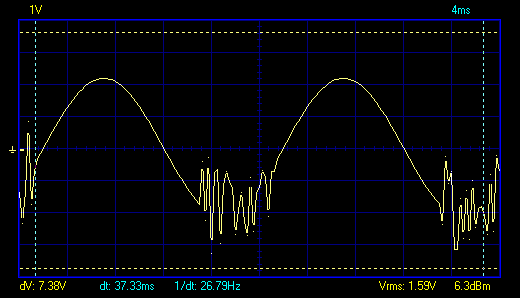
Ringing in a 50 Hz sine wave
Later, I learned that a compound pair transistor configuration, which this power amplifier makes use of, is more sensitive to oscillation compared to a darlington setup, especially on the negative side. Wiring the transistors off-board, instead of keeping them on the PCB, apparently caused the sensitive output stage to oscillate.
To reduce the amount of wiring, I changed it from point-to-point wiring of every base, collector and emitter, to a bus setup, using thick solid core wiring. This did not help much. In fact, the problem got worse. However, for reasons I don't really understand, the problem shown in the scope readout was solved by wiring each of the zobel networks seperately to the 0V return of the power supply, instead of wiring them to the 0V bus the transistor decoupler and bypass caps were connected to. Now only the 600 kHz oscillation remained, which would kick in when the amp was driven with a medium to high gain signal. To solve this, I cut some unused PCB tracks, added bypassing closer to sensitive stages, put a 10 Ohm/5 Watt resistor in series with the base of each final output transistor and I increased the dominant pole and inclusive miller capacitors from 100 pF to 220 pF. The latter decreases slew rate, and although I haven't don't any calculations, I think I still have enough slew rate for 50-60 Hz at full power... After these modifications, it has remained stable for years.
In future amplifiers, I will try to avoid off-board wiring of transistors, especially when it comes to wiring the driver transistors to their complementaries.
Another problem was serious false tripping of the DC protector at high volume. Initially, it seemed a result of asymmetrical clipping (and therefore, amplifier overloading). This dampened my spirits, because I had to reduce the lower frequencies in gain with the equalizer to prevent this false tripping. However, later, it also started happening with signals I was sure of weren't causing amplifier clipping. More research revealed the true cause, which was the turn on delay for the relay. Whenever the supply voltage would collapse and then increase again, the timer capacitor was being recharged, and therefore the relay was turned off. I notified Rod Elliot about the problem and he posted an update to the P33 article; a simple zener/resistor regulator was added to provide a stable voltage to the timer capacitor. I have built this updated version and it works perfectly. Because this same DC protector also had some problems with start-up relay chatter in my P3a based amplifier, I will use this updated version of P33 even when there is no apparent need.
4. Performance
To start with, the noise and hum level is very good. A very very very small buzz is audible when you press your ear against the driver, but it's absolutely nothing to worry about. There is no mechanical hum from the transformer.
The integration with my main system is quite well. For some music however, it appeared as though it wasn't. I could hear my main speakers as they sounded before, with deep bass added. This improved a lot when I undid my initial equaliser calibration. Because most of the bands were set louder than neutral, I decided to try to set them all to neutral and simply raise the volume a bit. Using your ears appearantly is not very accurate. When testing with frequency sweeps, I can still hear some dips and peaks, but until I get an SPL meter and take the time to calibrate, I'll (probably) leave the equaliser at neutral.
I am very happy with both music and movie performance. In both, it's well defined and reaches deep. The simlution predictions which indicated it might come up short, were luckily false, and reality was more forgiving indeed. The deepest rumbles in movies like Star Wars or U571 are very well produced. And because of my wooden floor, the revving engines at the beginning of the Pod Race in Star Wars I, make the room (and my chair) shake. It's also quite a cool thing to see 12.5 mm linear Xmax (or at least, a large portion of it) of the woofer at work :)
One of the remarks I got when I demonstrated it to a friend, was that the bass does not sound exagerated, but is able to really perform when it has to. This is exactly the intention, it's a subwoofer, not an extra woofer. I have no need for adding the bass I already had, or faking deep bass by amplifying the mid bass.
Now that it's part of my sound system, it's difficult to imagine to do without it again. It's only now that it's obvious what I was missing before, what most people's sound systems are missing. Especially movie experience has increased quite dramaticly. I much more have the tendancy to clamp the armrests of my chair now, and be really sucked into the experience.
This is the first equalized subwoofer (ELF or Linkwitz Transform) I have ever heared, and I can say now that ordinary subs pale in comparison (at least, the ones I've heard).
5. Future plans
The box might seem kind of "raw". This is unlikely to change, because I don't really care much about how it looks, aesthetically. I agree that it's cooler to have a cool looking unit, but I generally can't motivate myself to do the necessary work...
6. Photographs
For good measure, some photographs.
ELF processor.
Equalizer.
Small signal power supply.
DC protector.
Transformer softstarter.
Cabinet under construction, front view.
Cabinet under construction, back view.
All small signal elecronics, in the top of the unit.
The plate amplifier, with peripherals, for in the back of the unit. Not very tidy, I know...
The back of the unit. Small heatsink huh? It suffices for normal program material.
The final result.
7. References
- Another ELF Subwoofer
- ESP P33 DC protector
- ESP P68 subwoofer amplifier
- ESP P84 subwoofer equalizer
- ESP article about Linkwitz Transform
- ESP p48 ELF subwoofer controller
- My four channel P3a power amplifier
- Peerless 830847 subwoofer driver
- Tyler Thornblade about improving the Velleman K4700
- Tyler Thornblade about improving the Velleman K4700 - The Internet Archive
- Velleman K4700 loudspeaker protection
- WinISD Pro aplha speaker design software

